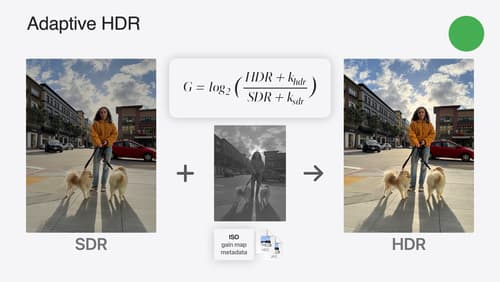UIImage optimizations
Asked on 2025-07-29
2 searches
The topic of UIImage optimizations was discussed in several sessions at WWDC. Here are some relevant insights:
-
HDR Image Handling: In the session titled "Use HDR for dynamic image experiences in your app," there are discussions on how to handle HDR images using
UIImage. The session covers automatic tone mapping forUIImageViewandSwiftUIviews, which ensures that HDR content is displayed optimally across different devices. This is particularly useful for applications that need to display adaptive HDR images. You can find more details in the Use HDR for dynamic image experiences in your app session. -
Dynamic Type and UIImage: The session "Get started with Dynamic Type" explains how to use
UIImagewith dynamic type settings. By usingUIImagesymbol configuration, you can ensure that images scale appropriately with text size changes, enhancing accessibility and user experience. More information can be found in the Get started with Dynamic Type session. -
Concurrency and UIImage Processing: In the session "Code-along: Elevate an app with Swift concurrency," there is a focus on optimizing image processing tasks using Swift concurrency. This involves moving image processing off the main thread to improve app responsiveness and performance. The session provides practical examples of using concurrency to handle image processing tasks efficiently. You can explore this topic further in the Code-along: Elevate an app with Swift concurrency session.
These sessions provide a comprehensive overview of how to optimize UIImage handling in various contexts, from HDR image display to dynamic type adjustments and concurrency optimizations.

Use HDR for dynamic image experiences in your app
Discover how to read and write HDR images and process HDR content in your app. Explore the new supported HDR image formats and advanced methods for displaying HDR images. Find out how HDR content can coexist with your user interface — and what to watch out for when adding HDR image support to your app.

Get started with Dynamic Type
Dynamic Type lets people choose their preferred text size across the system and all of their apps. To help you get started supporting Dynamic Type, we’ll cover the fundamentals: How it works, how to find issues with scaling text in your app, and how to take practical steps using SwiftUI and UIKit to create a great Dynamic Type experience. We’ll also show how you can best use the Large Content Viewer to make navigation controls accessible to everyone.

What’s new in UIKit
Modernize your app with the latest APIs in UIKit, including enhanced menu bar support, automatic observation tracking, a new UI update method, and improvements to animations. We’ll also cover how you can include SwiftUI scenes in your UIKit app and explore SF Symbols, HDR color pickers, and more.
